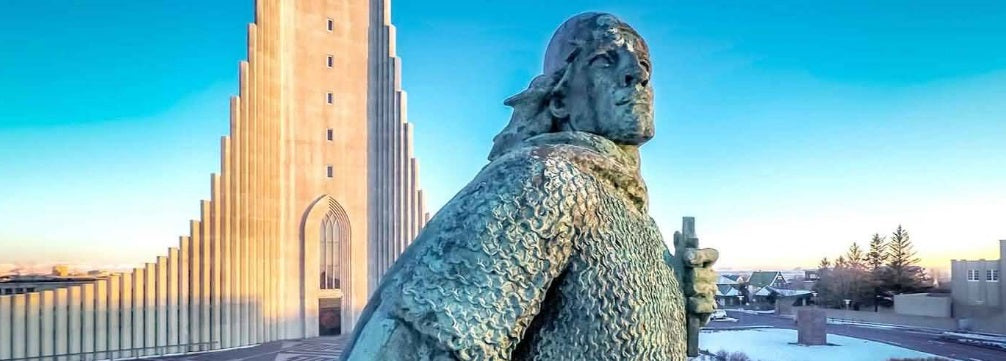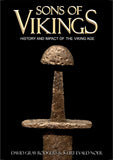Thanks for visiting our blog! As a thank-you, enjoy 15% off your first order in our online Viking Shop with the discount code BLOG15.
The Vikings in Greenland and America (part 2 of 4)
Part 1 (Erik the Red) is available here.
 King Olaf Tryggvason was the grandson of the famous Harald Fairhair, the tyrant who had united all of Norway in the early 10th century. Like his ancestor he was ambitious, but Olaf’s ambition was to make all of Norway Christian – by force if necessary. Olaf was very impressed with his new bodyguard, Leif Erikson (son of the famous Erik the Red). After Leif converted, King Olaf asked him to return to Greenland to spread Christianity there. Leif told his king that Christianity would be a hard sell in Greenland. Olaf insisted, saying, "I believe you would have good luck in it.” Leif graciously replied, “That could only be if I carry your good luck with me.” This was to prove prophetic, for when Leif left, King Olaf was soon after killed in battle.
King Olaf Tryggvason was the grandson of the famous Harald Fairhair, the tyrant who had united all of Norway in the early 10th century. Like his ancestor he was ambitious, but Olaf’s ambition was to make all of Norway Christian – by force if necessary. Olaf was very impressed with his new bodyguard, Leif Erikson (son of the famous Erik the Red). After Leif converted, King Olaf asked him to return to Greenland to spread Christianity there. Leif told his king that Christianity would be a hard sell in Greenland. Olaf insisted, saying, "I believe you would have good luck in it.” Leif graciously replied, “That could only be if I carry your good luck with me.” This was to prove prophetic, for when Leif left, King Olaf was soon after killed in battle.
Leif and about 35 men, found themselves lost on the high sea. At first, it may have seemed that their luck was against them. They became lost in a fog for days. However, when they finally did see land, it was not the barren hills of Greenland but a rocky coast of tall maple forests.
They explored the coast and several islands (most experts agree that these coastal finds were most likely Newfoundland, Nantucket, and/or the Labrador Coast of Canada). Winter was coming, so the party built a longhouse from the abundant timber.

They ate well on salmon, and they found wild grapes in abundance. A German in their company helped the Vikings make wine, which made for a merry winter, and thus the naming this country Vinland ('Wine Land'). Even in those coldest months of the year, the weather was warmer than any winter they had experienced in Greenland, Iceland, or Norway. The explorers noted that there was abundant grazing for livestock if they were to make a colony.
 Leif was not the first Viking to see North America. That distinction belongs to a man named Bjarn Herjulfson, who was too busy to stop and explore and was forever after ridiculed for that decision. However, Leif Erikson was the first recorded European to set foot on these shores.
Leif was not the first Viking to see North America. That distinction belongs to a man named Bjarn Herjulfson, who was too busy to stop and explore and was forever after ridiculed for that decision. However, Leif Erikson was the first recorded European to set foot on these shores.
The several months he spent in this strange land were peaceful. Though later Viking expeditions would be fraught with internal conflicts and battles with the Skraelings (Native Americans), Leif had no such troubles.After overwintering, Leif and his men loaded their ship full of timber and grapes and set sail for Greenland.
Off one of the North American islands they passed, Leif's keen eyes picked out a shipwreck in the fog. 15 survivors were clinging to life on the rocks. These desperate men could not believe their luck that another Norse ship should come by in time to rescue them. They were also Greenlanders, and the leader had even known Leif as a child. Leif took all the men aboard his ship and was able to salvage some of their cargo. From that day on, Leif Erikson was known as "Leif the Lucky."
Leif Returns Home
 Returning to barren Greenland with a boatload of lumber, wine, and rescued men, Leif the Lucky achieved instant fame. Everyone was eager for his tales of this Vinland, and to hear all that had befallen him serving a great king in Norway and exploring the unknown edges of Midgard.
Returning to barren Greenland with a boatload of lumber, wine, and rescued men, Leif the Lucky achieved instant fame. Everyone was eager for his tales of this Vinland, and to hear all that had befallen him serving a great king in Norway and exploring the unknown edges of Midgard.
Leif found that his new popularity opened doors for him to fulfill his promise to King Olaf, too, and many Greenlanders accepted Christianity. Among those was Leif's mother, Thodhild.
Erik the Red was happy to see his son but did not think much of his new religion. When Thodhild refused to sleep with Erik until he converted, the saga says, “… this was a great trial to his temper.”
Erik's older son, Thorstein, wanted to mount his own expedition to America immediately, perhaps uncomfortable that his little brother was eclipsing him. He urged Erik the Red to go with him. Erik was reluctant but eventually decided to go. On the way to the ship, though, Erik fell off his horse, injuring his ribs and shoulder. So, Erik stayed home, and it was just as well – for Thorstein's voyage was ill-fated. The ship blew around on the waves all season without finding America, and so they returned home empty-handed.
That winter, there was a plague in Greenland and Leif's father, Erik the Red died. He was about 51 years old. Leif the Lucky was made the new leader of the Greenlanders after him. We have no tale of Leif ever returning to the lands he discovered, but others certainly would – including the other sons and daughter of the intrepid, irascible Erik the Red.
Part 3 is available here.
References:
- Grœnlendinga Saga - The Saga of the Greenlanders. Accessed August 16, 2018.
- Sephton, J. The Saga of Erik the Red. 1880. Accessed August 16, 2018. http://sagadb.org/eiriks_saga_rauda.en
- Mandia, S. Vikings During the Medieval Warm Period. Accessed August 16, 2018, http://www2.sunysuffolk.edu/mandias/lia/vikings_during_mwp.html
- Mandia, S. The End of the Vikings in Greenland. Accessed August 16, 2018, http://www2.sunysuffolk.edu/mandias/lia/end_of_vikings_greenland.html
- Mandia, S. The Little Ice Age in Europe. Accessed August 16, 2018, http://www2.sunysuffolk.edu/mandias/lia/little_ice_age.html
- Brownworth, L. The Sea Wolves: A History of the Vikings. Crux Publishing, Ltd. The United Kingdom. 2014.
- Brown, N. M. Ivory Vikings: The Mystery of the Most Famous Chessmen in the World and the Woman Who Made Them.St Martin’s Press. New York, NY. 2015
- Shoalts, A. Reverse Colonialism: How the Inuit Conquered the Vikings. Canadian Geographic. March 2011. Accessed August 16, 2018.
- Dougherty, Martin J., A Dark History: Vikings. Metro Books, New York. 2013.
- Rodgers, D.G. & Noer, K. Sons of Vikings: History, Legends, and Impact of the Viking Age. 2018.
- Anderson, D. Vikings In North America? New Evidence Points To Extended Occupation In Newfoundland. Forbes. July 22, 2019. https://www.forbes.com/sites/davidanderson/2019/07/22/vikings-in-north-america-new-evidence-points-to-extended-occupation-in-newfoundland/#10c2868146d8
- L’Anse aux Meadows National Historic Site. UNESCO. https://whc.unesco.org/en/list/4/
- Pastore, R. The Beothuk. Heritage Newfoundland and Labrador. 1997. https://www.heritage.nf.ca/articles/aboriginal/beothuk.php
- Vikings in North America: A Saga’s New Chapter. National Geographic History Magazine. November 12, 2016.
Image Sources:
https://www.ancient.eu/Vinland/
http://www.nationalpedia.com/wp-content/uploads/2017/09/National-Leif-Erickson-Day-October-9.png
Sons of Vikings is an online store offering hundreds of Viking inspired items, including Viking jewelry, Viking clothing, Drinking horns, home decor items and more.
To learn more about Viking history, we recommend our 400+ page, self titled book that is available here.


